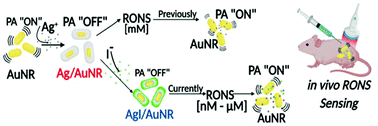Accumulation of reactive oxygen and nitrogen species (RONS) can induce cell damage and even cell death. RONS are short-lived species, which makes direct, precise, and real-time measurement difficult. Biologically-relevant RONS levels are in the nM–μM scale; hence, there is a need for highly sensitive RONS probes. We previously used hybrid gold-core silver-shell nanoparticles with mM sensitivity to H2O2. These particles reported the presence of RONS via spectral shifts which could easily be quantified via photoacoustic imaging. Here, we used halide doping to tune the electrochemical properties of these materials to better match the oxidation potential of RONS. This work describes the synthesis, characterization, and application of these AgI-coated gold nanorods (AgI/AuNR). The I : Ag molar ratio, pH, and initial Ag shell thickness were optimized for good RONS detection limits. Halide doping lowers the reduction potential of Ag from  to
to  resulting in a 1000-fold increase in H2O2 and 100 000-fold increase in ONOO− sensitivity. The AgI/AuNR system also etches 45-times faster than undoped Ag/AuNR. The AgI/AuNR easily reported the endogenously produced RONS in established cells lines as well as murine models.
resulting in a 1000-fold increase in H2O2 and 100 000-fold increase in ONOO− sensitivity. The AgI/AuNR system also etches 45-times faster than undoped Ag/AuNR. The AgI/AuNR easily reported the endogenously produced RONS in established cells lines as well as murine models.
